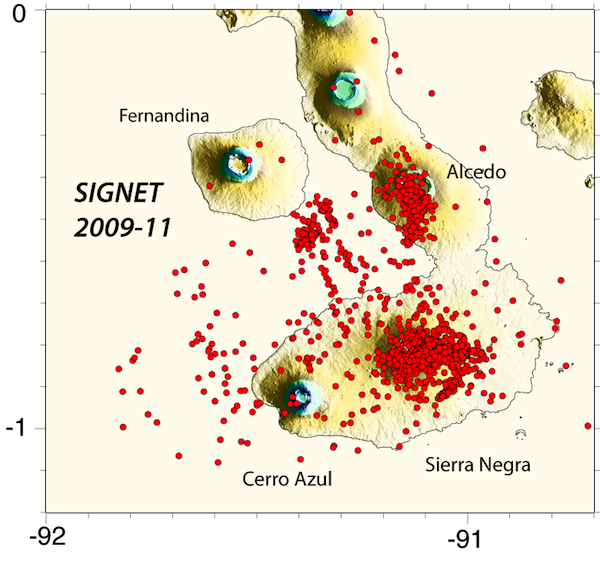2012 IRIS Workshop
Imaging Crustal Magma Reservoirs Beneath Sierra Negra and Cerro Azul Volcanoes, Galapagos
Gabrielle Tepp:, Manahloh Belachew:, Cynthia Ebinger: EES Department, University of Rochester, Mario Ruiz: IGEPN, Ecuador, L Davidge: EES Department, University of Rochester
Distribution of seismicity (0.5 < ML < 3) recorded on the SIGNET array, Galapagos August 2009-June 2011. This distribution provides good ray coverage for wavespeed crustal tomography.

Full-resolution graphics file in original format: 0099.png
Oceanic intraplate volcanoes form above anomalously hot asthenosphere through repeated eruptions of primarily basaltic magma. Significant volumes of magma are intruded as basaltic dikes, stored in shallow crustal chambers, or trapped near the crust-mantle boundary as underplated sills, permanently thickening the crust. Despite the importance of these processes, we have few observations from ocean islands to constrain the volume and distribution of magma accreted at the top, within, and at the base of the crust, or of the changes in stress accompanying magma intrusion. The active volcanoes of the western Galapagos chain are some of the most rapidly deforming volcanoes in the world, affording a strong signal for subsurface imaging. The SIGNET seismic array (2009-2011) provide, for the first time, a baseline for monitoring Sierra Negra volcano, as well as activity levels at Cerro Azul, Alcedo, and Fernandina volcanoes and the shallow platforms immediately outside our array. Using data from IGEPN and SIGNET, we estimate a b-value of 1.10 and predict a maximum earthquake magnitude of ~6. Based on double-difference locations, seismicity is largely restricted to the uppermost 2 km of Sierra Negra, except for the pipe-like zone beneath the eastern side of the caldera. Depths of earthquakes on Alcedo and the shallow platform outside the array are poorly constrained. Seismicity is localized around the caldera ring fault system and the sinuous ridge marking the trap-door fault system. Swarms of seismicity coincide with aligned chains of cinder cones and vents between Sierra Negra and Cerro Azul, between Sierra Negra and Alcedo, between Sierra Negra and Santa Cruz, and along the southern flank of Isabela Island near the only port town, Villamil (Figure 1). Migrating swarms of seismicity beginning in the caldera may mark small volume radial dike intrusions. Scattering and attenuation are high, and LP tremor detected at the Sierra Negra caldera and rim stations occurs freq
Acknoweldgements: Data acquisition and analyses are supported by NSF grant EAR- 0838467. The seismic instruments were provided by the Incorporated Research Institutions for Seismology through the PASSCAL Instrument Center at New Mexico Tech. Data is available through the IRIS Data Management Center. The facilities of the IRIS Consortium are supported by the National Science Foundation under Cooperative Agreement EAR-0552316, NSF Office of Polar Programs and DOE National Nuclear Security Administration.
Keywords: tomography
